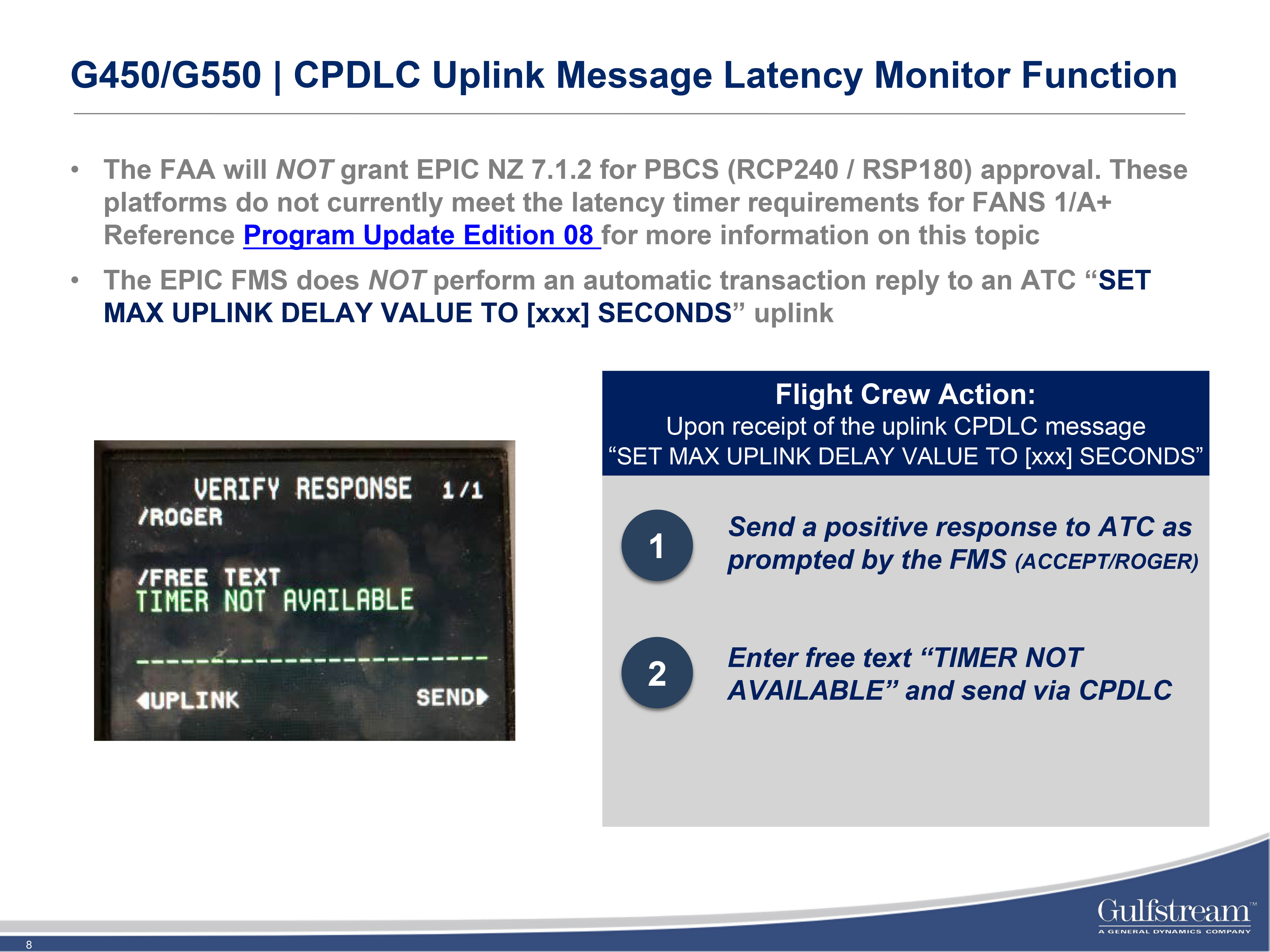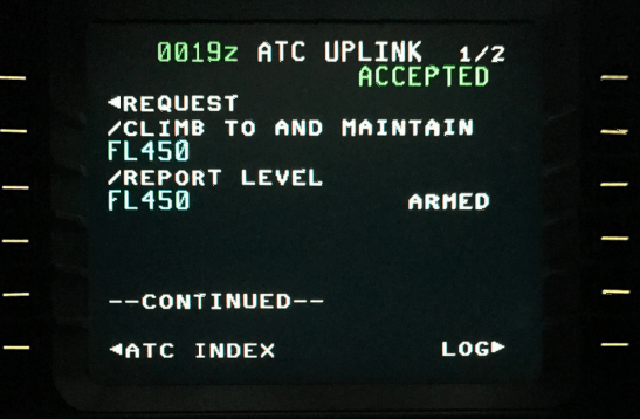When we first got into data link our manufacturer told us that a latency timer was old school technology that only affected older Boeing and Airbus aircraft that didn't have our level of bells and whistles. They told us not to worry about it, so we didn't. As it turns out, we were missing a big part of data link. If your data link doesn't have a latency timer, you are missing an important part of the equation.
— James Albright

Updated:
2017-09-15
A latency timer basically checks the time a data link message was sent to you versus the time it receives it, and prevents old messages from being presented as current ATC instructions. Some data link installations do not have latency timers.

1
A recent history
The intention of the message latency monitor function is to prevent pilots from acting on a CPDLC uplink message that has been delayed in the network. The most serious of such cases would be the pilot executing a clearance that was no longer valid.
Source: NAT OPS Bulletin 2018-002, ¶2.1
The best way to illustrate a latency timer's importance is from examples where there was no latency timer and something went wrong.
Here’s what happened:
- On Sep 12th, an Alaskan Airlines flight had a failure of their CMU (Comms Management Unit) that caused the Iridium connection to stop working. An ATC message was sent to the aircraft but not delivered. On the next flight, the CMU power was reset and corrected the issue, and the pending message was delivered. The CMU did not recognise the message as being old, and so it was presented to the Flight Crew as a control instruction. FSB understands that this aircraft took the climb instruction and executed the level change, climbing 1000 feet.
- Another flight, operated by Hawaiian out of Oakland, had a similar problem. This aircraft had both Iridium and Inmarsat on board, and during the flight switched over to Inmarsat as the provider. An ATC message was routed via Iridium, but didn’t reach the aircraft before the switch. Some 23 hours later, on the next flight, Iridium was activated again and again the ATC message presented as a “live” instruction. On this occasion, the crew queried the instruction and did not climb.
- The problem in simple terms is that if ATC sends a CPDLC message like “Climb FL 370“, which is obviously only valid for “right now”, but another crew gets the message hours later, then you have a very high risk of the new crew accepting that and climbing.
- For now, Iridium has a plan to fix the ground side to not allow older SBD messages to be delivered, and they say they are testing it at the moment and expect to release it soon.
Source: Ops.Group, 18 October 2017
The problem with Iridium has been fixed, but this illustrates why a latency timer is needed.
2
ICAO Gold
The ICAO "GOLD" manual covers Global Operational Data Link procedures and is the foundation for the latency timer requirement.
2.1.2.6 Message latency monitor
2.1.2.6.1 An ATS unit may implement automation to support use of a message latency monitor on the aircraft. The extent to which automation supports controller procedures that use the message latency monitor is a local matter.
2.1.2.6.2 The use of the message latency monitor, available on all ATN B1 aircraft and FANS 1/A+ aircraft, can provide the ANSP a means to mitigate the effects of a delayed CPDLC message that is delivered to the aircraft, and contributes to meeting the safety requirements for the ATS unit and the aircraft. Refer to Doc 9869 for specific safety requirements associated with each RCP specification.
2.1.2.6.3 The ANSP should consider the effects of a delayed CPDLC message in accordance with 2.1.1.1 and identify mitigating measures.
Note 1.— A FANS 1/A ATS unit or a FANS 1/A–ATN B1 ATS unit, providing CPDLC services to FANS 1/A aircraft does not use the message latency monitor. To mitigate the effects of a delayed CPDLC message, the ATS unit may apply the following alternative mitigation measures:
a) specify, in a contract or service agreement with the communication service provider, provisions that would preclude the delivery of a delayed CPDLC message to an aircraft; or
b) perform the procedure described in 3.3.1.2.
Note 2.— An ATN B1 ATS unit or a FANS 1/A-ATN B1 ATS unit providing CPDLC services to ATN B1 aircraft may use the message latency monitor as mitigation against a delayed CPDLC message. The procedures are applicable only in the European Region and are described in Appendix B, B.2.3.2.
4.2.1.9 The flight crew may receive a CPDLC free text message from the ATS unit or a flight deck indication regarding the use of the message latency monitor on FANS 1/A+ aircraft. When this message is received, the flight crew should respond as described in Table 4-1 and in accordance with procedures for the specific aircraft type.
Note 1.— Procedures associated with the message latency monitor are applicable only in the European Region and are described in Appendix B, B.2.3.2.
Note 2.— FANS 1/A aircraft do not support the message latency monitor. Refer to Appendix C, C.1 for availability of a FANS 1/A+ upgrade on different types of aircraft. Refer to Appendix C, C.11 for the specifications of the message latency monitor on different types of aircraft.
Source: ICAO Doc 10037

Latency monitor messages, ICAO Doc 10037, table 4-1
4.3.2.1 System performance requirements have been established to support reduced separation standards. Specific latency times have been allocated to the technical performance and flight crew and controller response times. Regional/State monitoring agencies analyse actual performance to ensure the technical and operational components of the system meet required standards. For example, to support RCP 240 operations, the flight crew is expected to be able to respond to a CPDLC uplink message within one minute.
B.2.3.2 Latency time monitor (LTM)
B.2.3.2.1 In accordance with safety requirement SR-ACL-13 of ED120/DO290, the message latency monitor defined in ED100A/DO258A, 4.6.6.9 and ED110B/DO280B (ATN), 3.3.4 provides to the ANSP a means to mitigate the effects of an excessively delayed CPDLC message. In Europe, this message latency monitor is referred to as the LTM.
Note.— The LTM function is not used by FANS 1/A+ aircraft (refer to B.2.2.3.4 b) for alternative procedure).
B.2.3.2.2 An ATN B1 compliant aircraft has an LTM function in the form of a hard-coded LTM value in the avionics. The LTM value is set at 40 seconds.
B.2.3.2.3 Upon activation of the LTM, the aircraft system will:
a) display the message to the flight crew with a delayed message indication. The flight crew should contact the controller and advise him/her of the situation and/or request verification of ATC intent; or
b) discard the message without any indication to the flight crew and notify the controller with a message consisting of DM 62 ERROR (error information] and DM 98 (UPLINK DELAYED IN NETWORK AND REJECTED. RESEND OR CONTACT BY VOICE). The controller should revert to voice to clarify the situation.
Source: ICAO Doc 10037
3
Pilot procedures
This is an issue wherever CPDLC is in use. The place it matters the most, as of 2018, is in the North Atlantic; so we'll look at that first.
What to do about it depends on the airplane and if it has a latency timer. We'll look at two Gulfstreams, one without and one with a latency timer.
North Atlantic
3.1 Pilots shall be familiar with aircraft functionality that concerns the CPDLC uplink message latency monitor.
3.2 When the pilot receives the uplink CPDLC message SET MAX UPLINK DELAY VALUE TO [delayed message parameter] SECONDS he/she shall:
a) Send a positive response to ATC as prompted by the avionics (ACCEPT [ROGER]) regardless of whether the aircraft supports the latency monitor.
Note 1: It is important that pilots respond to the SET MAX UPLINK DELAY VALUE TO [delayed message parameter] SECONDS uplink message to avoid having open unanswered CPDLC messages in the system. This also applies to aircraft that have deficient message latency monitor functionality or no such functionality at all.
Note 2: The Global Operational Data Link Manual specifies that the pilot should append the response downlink with the free text message TIMER NOT AVAILABLE when the message latency monitor function is not available in the aircraft (refer to GOLD Table 4-1).
b) If the aircraft is equipped with a correctly functioning message latency monitor, enter the specified uplink delay into the avionics in accordance with the aircraft procedures. Some avionics will automatically set the delay value in accordance with the uplink message and do not allow for a manual input.
Note 3: If an aircraft is instructed to log off and then log on again mid-flight, ATC may send the message SET MAX UPLINK DELAY VALUE TO [delayed message parameter] SECONDS again once the logon is completed.
3.3 When a pilot receives a CPDLC uplink message with an indication that the message has been delayed the pilot shall:
a) Revert to voice communications to notify the ATS unit of the delayed message received and to request clarification of the intent of the CPDLC message; and
b) Respond appropriately to close the message as per the instructions of the controller.
c) The pilot must not act on the delayed uplink message until clarification has been received from the controller.
Source: NAT OPS Bulletin 2018-002, ¶3
Aircraft without a latency timer example (Gulfstream G450 without ASC 912)
Although this was fixed in 2019 with Aircraft Service Change 912, for the sake of example here is how G450 pilots without that ASC are to respond when directed to "Set max uplink delay value to xxx seconds."

G450 latency timer response, Gulfstream All Aircraft CPDLC Uplink Message Latency Monitor presentation.
ATC is asking these pilots to set a maximum value into their latency monitors. These pilots respond by saying "timer not available," telling ATC to keep an eye on them. These airplanes can be denied some airspace as a result.
Aircraft with a latency monitor example (Gulfstream G500)
Aircraft with latency timers that do not respond to this message automatically will require pilots to set the appropriate value and send a response.

G500 latency timer response, Gulfstream All Aircraft CPDLC Uplink Message Latency Monitor presentation.
Aircraft with a latency monitor and automatic function example (Gulfstream G280)
Some aircraft with latency timers that respond to this message automatically do not require pilot action.
References
(Source material)
Gulfstream CPDLC Uplink Message Latency Monitor Function, 02 May 2018.
ICAO Doc 10037, Global Operational Data Link (GOLD) Manual, First Edition, 2017, International Civil Aviation Organization
Iridium fault prompts ban by Oceanic ATC, Ops.Group, 17 October 2017
NAT OPS Bulletin 2018-02, Latency Monitor, Rev 01, 4 June 2018
Please note: Gulfstream Aerospace Corporation has no affiliation or connection whatsoever with this website, and Gulfstream does not review, endorse, or approve any of the content included on the site. As a result, Gulfstream is not responsible or liable for your use of any materials or information obtained from this site.
